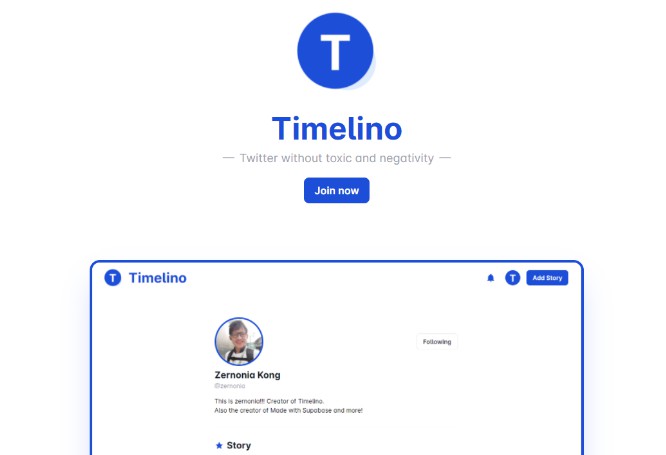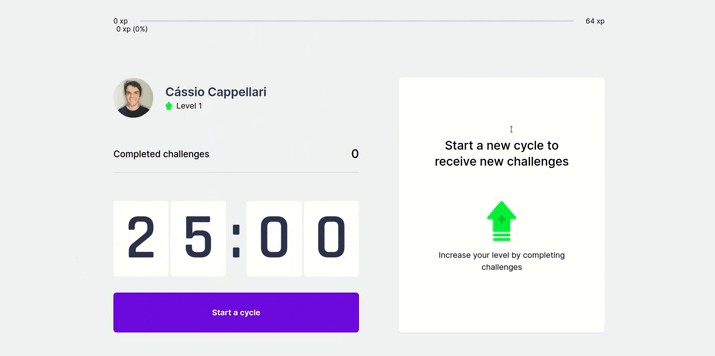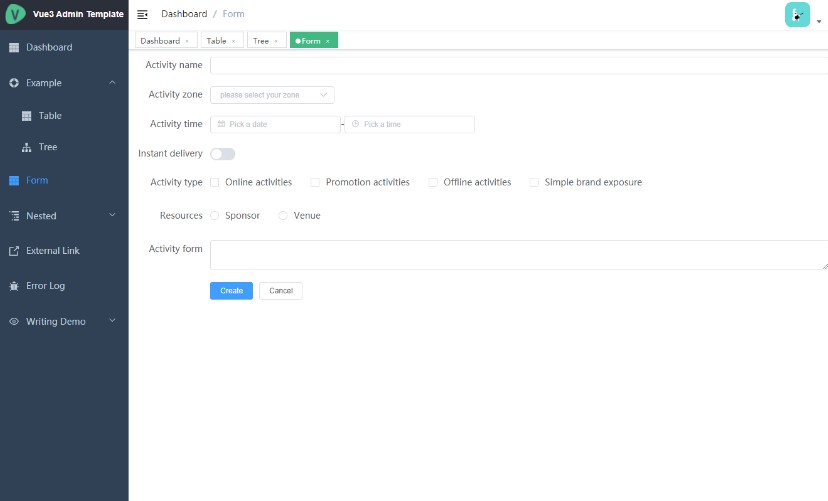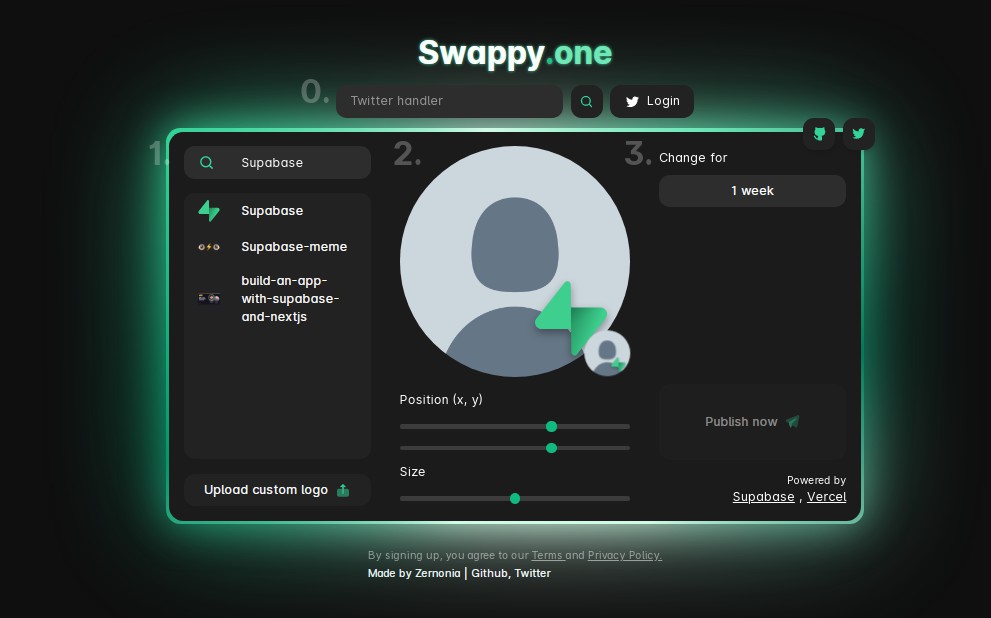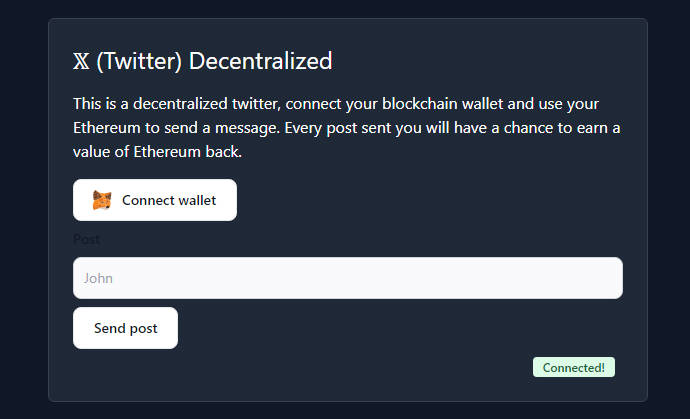Timelino
Twitter-liked platform without toxic and negativity
Open Source • Super Early MVP
View Demo
·
Report Bug
·
Request Feature
? Features
- ? Showcase your creation, idea, or life style
- ? Simple login (Google, email)
- ? No comment system (No hate/negativity)
- ? Editable timeline
- ? Ads-free
? About The Project
Twitter without toxic and negativity
The main purpose of this idea is to create a toxic-free and negativity-free platform for users to share their latest creation or idea. This is actually to solve my own craving for a platform like this.
Scope
This project turns out to be quite a challenge for me, as I’m currently still having a full-time job, and the complexity of the relational database is not my forte yet. But I somehow managed to say this is the MVP for this project.
Inspiration
I saw a few post on Twitter where the user decided to leave the platform because of the negativity, and all the hates.
Furthermore, Polywork inspired me to create a platform for those user. I didn’t enjoy Polywork because of its super high complexity for someone who just wanted to post a simple story on my timeline. Thus, I look this liberty, and challenge to create this platform.
? Built With
⚡ Supabase
- Supabase Auth
- Supabase Database
- Supabase Storage
- Supabase Realtime (for Notications)
Database Schema
Schema generated by Supabase Schema
Custom SQL
Most of the tables was generated using Supabase Dashboard, but altered using custom script. Unfortunately, I forgot to save those script. But the SQL functions and triggers are listed below.
1 – Handle New User (Function & Trigger)
/**
* This trigger automatically creates a user entry when a new user signs up via Supabase Auth.
*/
create or replace function public.handle_new_user()
returns trigger as $$
begin
insert into public.profiles (id, avatar_url, full_name)
values (new.id, new.raw_user_meta_data->>'avatar_url', new.raw_user_meta_data->>'full_name');
return new;
end;
$$ language plpgsql security definer;
create trigger on_auth_user_created
after insert on auth.users
for each row execute procedure public.handle_new_user();
2 – Handle New Follower (Function & Trigger) (WIP)
/**
* This trigger automatically creates a nofication entry when a user follow other user.
*/
create or replace function public.handle_new_follower()
returns trigger as $$
begin
insert into public.notifications (target_id, type, payload, source_id)
values (
new.following_id,
'follow',
(select row_to_json(c) from (select b.username, b.avatar_url from followers a left join profiles b on a.user_id = b.id where a.user_id = new.user_id limit 1) c),
new.user_id
);
return new;
end;
$$ language plpgsql security definer;
3 – Get User’s Story (Function)
/**
* This function populate the story with tagging details.
*/
create or replace function get_stories (user_name text)
returns table (id uuid, date date, story text, tagging uuid[], user_id uuid, image text, created_at timestamp, tags json)
language plpgsql
as
$$
begin
return query
select a.*, json_agg(b) as tags from stories a left join tags b on b.id = any(a.tagging) where a.user_id = (select c.id from profiles c where c.username = user_name) group by a.id;
end;
$$
4 – Get User’s Story (Function)
/**
* This function populate the story with filtered tagging details.
*/
create or replace function get_tagged_stories (user_name text, tag_id uuid)
returns table (id uuid, date date, story text, tagging uuid[], user_id uuid, image text, created_at timestamp, tags json)
language plpgsql
as
$$
begin
return query
select a.*, json_agg(b) as tags from stories a left join tags b on b.id = any(a.tagging) where a.user_id = (select c.id from profiles c where c.username = user_name) and b.id = tag_id group by a.id;
end;
$$
5- Get Story of the user you follow (Function)
/**
* This function returns the stories of the users you are following. Used in '/home'.
*/
create or replace function get_following_stories ()
returns table (id uuid, date date, story text, tagging uuid[], user_id uuid, image text, created_at timestamp, tags json, user_data json)
language plpgsql
as
$$
begin
return query
select d.*, row_to_json(e) as user_data from profiles e right join
(select a.*, json_agg(b) as tags
from stories a
left join tags b
on b.id = any(a.tagging)
where a.user_id in (select c.following_id from followers c where c.user_id = auth.uid())
group by a.id
order by created_at desc
) d
on e.id = d.user_id
;
end;
$$
6 – Get Suggested User (Function) (WIP)
/**
* This function returns profiles that you should follow. WIP
*/
create or replace function get_suggested_user()
returns setof profiles
language plpgsql
as
$$
begin
return query
select * from profiles where id <> auth.uid() order by random();
end;
$$
➕ Contributing
If you like this project, and see potential in it, feel free to reach out to me at Twitter (@zernonia) or [email protected]
? License
Not Associated with Supabase.
Distributed under the MIT License. See LICENSE for more information.
? Contact
Zernonia – @zernonia – [email protected]
Also, if you like my work, please buy me a coffee ☕?
